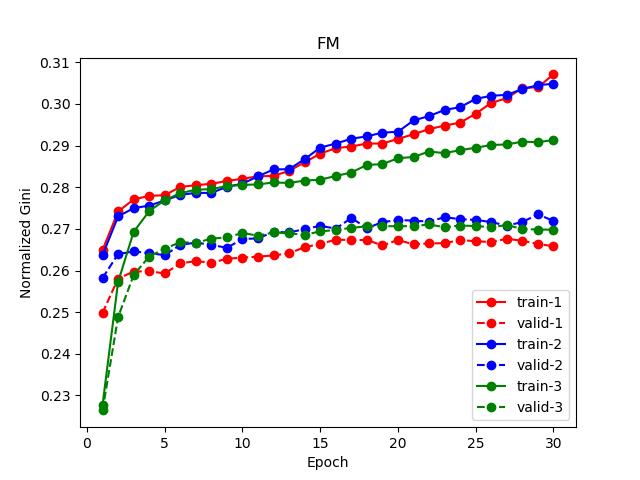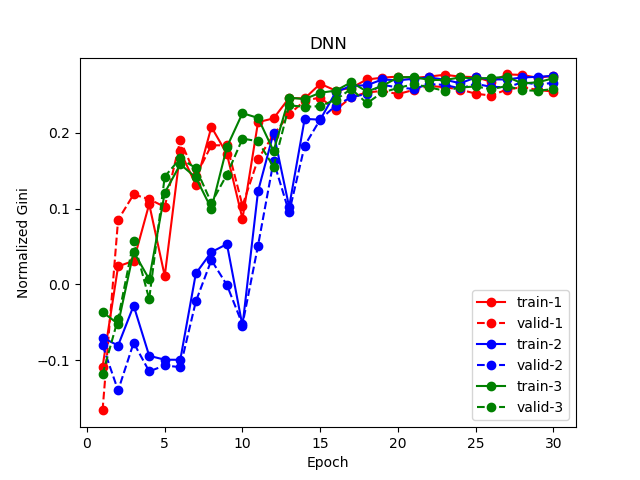This project includes a Tensorflow implementation of DeepFM [1].
- A modified version of DeepFM is used to win the 4th Place for Mercari Price Suggestion Challenge on Kaggle. See the slide here how we deal with fields containing sequences, how we incoporate various FM components into deep model.
This implementation requires the input data in the following format:
- Xi: [[ind1_1, ind1_2, ...], [ind2_1, ind2_2, ...], ..., [indi_1, indi_2, ..., indi_j, ...], ...]
- indi_j is the feature index of feature field j of sample i in the dataset
- Xv: [[val1_1, val1_2, ...], [val2_1, val2_2, ...], ..., [vali_1, vali_2, ..., vali_j, ...], ...]
- vali_j is the feature value of feature field j of sample i in the dataset
- vali_j can be either binary (1/0, for binary/categorical features) or float (e.g., 10.24, for numerical features)
- y: target of each sample in the dataset (1/0 for classification, numeric number for regression)
Please see example/DataReader.py an example how to prepare the data in required format for DeepFM.
import tensorflow as tf
from sklearn.metrics import roc_auc_score
# params
dfm_params = {
"use_fm": True,
"use_deep": True,
"embedding_size": 8,
"dropout_fm": [1.0, 1.0],
"deep_layers": [32, 32],
"dropout_deep": [0.5, 0.5, 0.5],
"deep_layers_activation": tf.nn.relu,
"epoch": 30,
"batch_size": 1024,
"learning_rate": 0.001,
"optimizer_type": "adam",
"batch_norm": 1,
"batch_norm_decay": 0.995,
"l2_reg": 0.01,
"verbose": True,
"eval_metric": roc_auc_score,
"random_seed": 2017
}
# prepare training and validation data in the required format
Xi_train, Xv_train, y_train = prepare(...)
Xi_valid, Xv_valid, y_valid = prepare(...)
# init a DeepFM model
dfm = DeepFM(**dfm_params)
# fit a DeepFM model
dfm.fit(Xi_train, Xv_train, y_train)
# make prediction
dfm.predict(Xi_valid, Xv_valid)
# evaluate a trained model
dfm.evaluate(Xi_valid, Xv_valid, y_valid)
You can use early_stopping in the training as follow
dfm.fit(Xi_train, Xv_train, y_train, Xi_valid, Xv_valid, y_valid, early_stopping=True)
You can refit the model on the whole training and validation set as follow
dfm.fit(Xi_train, Xv_train, y_train, Xi_valid, Xv_valid, y_valid, early_stopping=True, refit=True)
You can use the FM or DNN part only by setting the parameter use_fm or use_dnn to False.
This implementation also supports regression task. To use DeepFM for regression, you can set loss_type as mse. Accordingly, you should use eval_metric for regression, e.g., mse or mae.
Folder example includes an example usage of DeepFM/FM/DNN models for Porto Seguro's Safe Driver Prediction competition on Kaggle.
Please download the data from the competition website and put them into the example/data folder.
To train DeepFM model for this dataset, run
$ cd example
$ python main.py
Please see example/DataReader.py how to parse the raw dataset into the required format for DeepFM.
- You should tune the parameters for each model in order to get reasonable performance.
- You can also try to ensemble these models or ensemble them with other models (e.g., XGBoost or LightGBM).
[1] DeepFM: A Factorization-Machine based Neural Network for CTR Prediction, Huifeng Guo, Ruiming Tang, Yunming Yey, Zhenguo Li, Xiuqiang He.
This project gets inspirations from the following projects:
- He Xiangnan's neural_factorization_machine
- Jian Zhang's YellowFin (yellowfin optimizer is taken from here)
MIT


